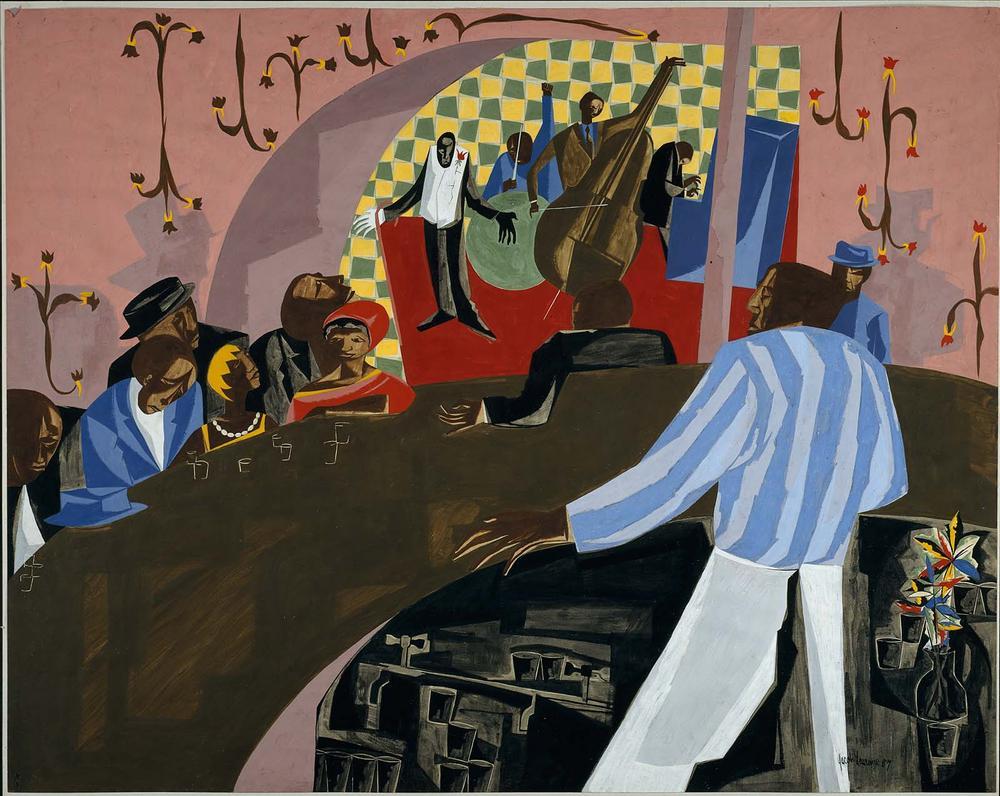Advanced Search 

Café Comedian
Jacob Lawrence (American, 1917–2000)
1957
Medium/Technique
Casein on paper
Dimensions
58.42 x 73.66 cm (23 x 29 in.)
Credit Line
Gift of William H. and Saundra B. Lane and Museum purchase
Accession Number1990.378
NOT ON VIEW
CollectionsContemporary Art, Americas
ClassificationsPaintings
Throughout his career of more than sixty years Jacob Lawrence, one of America's most important and respected black artists, told the story of African American lives and culture through figurative paintings, often in series and frequently with biting social commentary. Lawrence achieved success at an astonishingly early age, holding his first one-man exhibition by the time he was twenty. He had moved to Harlem from Philadelphia at the age of thirteen, in 1931, and he benefited from the flowering of black culture known as the Harlem Renaissance. Much of his art was stimulated by the writers, musicians, and artists of this cultural movement, as well as by the street-corner orators who related episodes of black history that were not included in textbooks.
In 1942 Lawrence executed a series of thirty paintings relating to life in Harlem. He revisited this subject in the mid-1950s, exploring the world of entertainment which had drawn many to Harlem since the 1920s. "Café Comedian" displays Lawrence's use of bold colors and patterns, a legacy from his early days when he noticed that people were so poor that they decorated their homes with bold colors and patterns to brighten their lives. In the painting, these syncopated hues and textures-especially the note-like designs cascading down the pink walls-serve as the visual expression of the music being played by the trio of musicians in the background. Eschewing linear perspective, Lawrence has indicated the position of the performers in an alcove or adjoining room by means of their smaller scale and their placement higher in the painting.
Lawrence's style has been compared to Pablo Picasso's Synthetic Cubism and also to collage, both of which convey spatial depth through the overlapping of flat forms. Knowledgeable about Western art traditions, Lawrence had often visited the Metropolitan Museum of Art as a teenager. There, he studied the social criticism of artists such as Honoré Daumier and the narrative elements and use of tempera paint in early Renaissance paintings. Rather than oils, Lawrence consistently used opaque water-based paints, which dictated his flat, two-dimensional forms. He often left areas unpainted and let the ground show through, as in the bartender's hand seen here.
Despite its bright colors, "Café Comedian" conveys an underlying sense of melancholy. This emotion is evident in the darker colors in the bottom half of the painting and most especially in the morose facial expressions of the men at the bar. Such ambiguity is common in Lawrence's work of the 1950s.
This text was adapted from Davis, et al., MFA Highlights: American Painting (Boston, 2003) available at www.mfashop.com/mfa-publications.html.
In 1942 Lawrence executed a series of thirty paintings relating to life in Harlem. He revisited this subject in the mid-1950s, exploring the world of entertainment which had drawn many to Harlem since the 1920s. "Café Comedian" displays Lawrence's use of bold colors and patterns, a legacy from his early days when he noticed that people were so poor that they decorated their homes with bold colors and patterns to brighten their lives. In the painting, these syncopated hues and textures-especially the note-like designs cascading down the pink walls-serve as the visual expression of the music being played by the trio of musicians in the background. Eschewing linear perspective, Lawrence has indicated the position of the performers in an alcove or adjoining room by means of their smaller scale and their placement higher in the painting.
Lawrence's style has been compared to Pablo Picasso's Synthetic Cubism and also to collage, both of which convey spatial depth through the overlapping of flat forms. Knowledgeable about Western art traditions, Lawrence had often visited the Metropolitan Museum of Art as a teenager. There, he studied the social criticism of artists such as Honoré Daumier and the narrative elements and use of tempera paint in early Renaissance paintings. Rather than oils, Lawrence consistently used opaque water-based paints, which dictated his flat, two-dimensional forms. He often left areas unpainted and let the ground show through, as in the bartender's hand seen here.
Despite its bright colors, "Café Comedian" conveys an underlying sense of melancholy. This emotion is evident in the darker colors in the bottom half of the painting and most especially in the morose facial expressions of the men at the bar. Such ambiguity is common in Lawrence's work of the 1950s.
This text was adapted from Davis, et al., MFA Highlights: American Painting (Boston, 2003) available at www.mfashop.com/mfa-publications.html.
Catalogue Raisonné
Nesbett and DuBois P57-04
InscriptionsLower right: Jacob Lawrence 57
Provenance1958, sold by Alan Gallery, New York to William H. Lane (b. 1914 - d. 1995), Leominster, MA; 1990, partial sale and partial gift of William H. and Saundra B. Lane to the MFA. (Accession date: June 27, 1990)
Copyright© Gwendolyn Knight Lawrence, courtesy of the Jacob and Gwendolyn Lawrence Foundation
